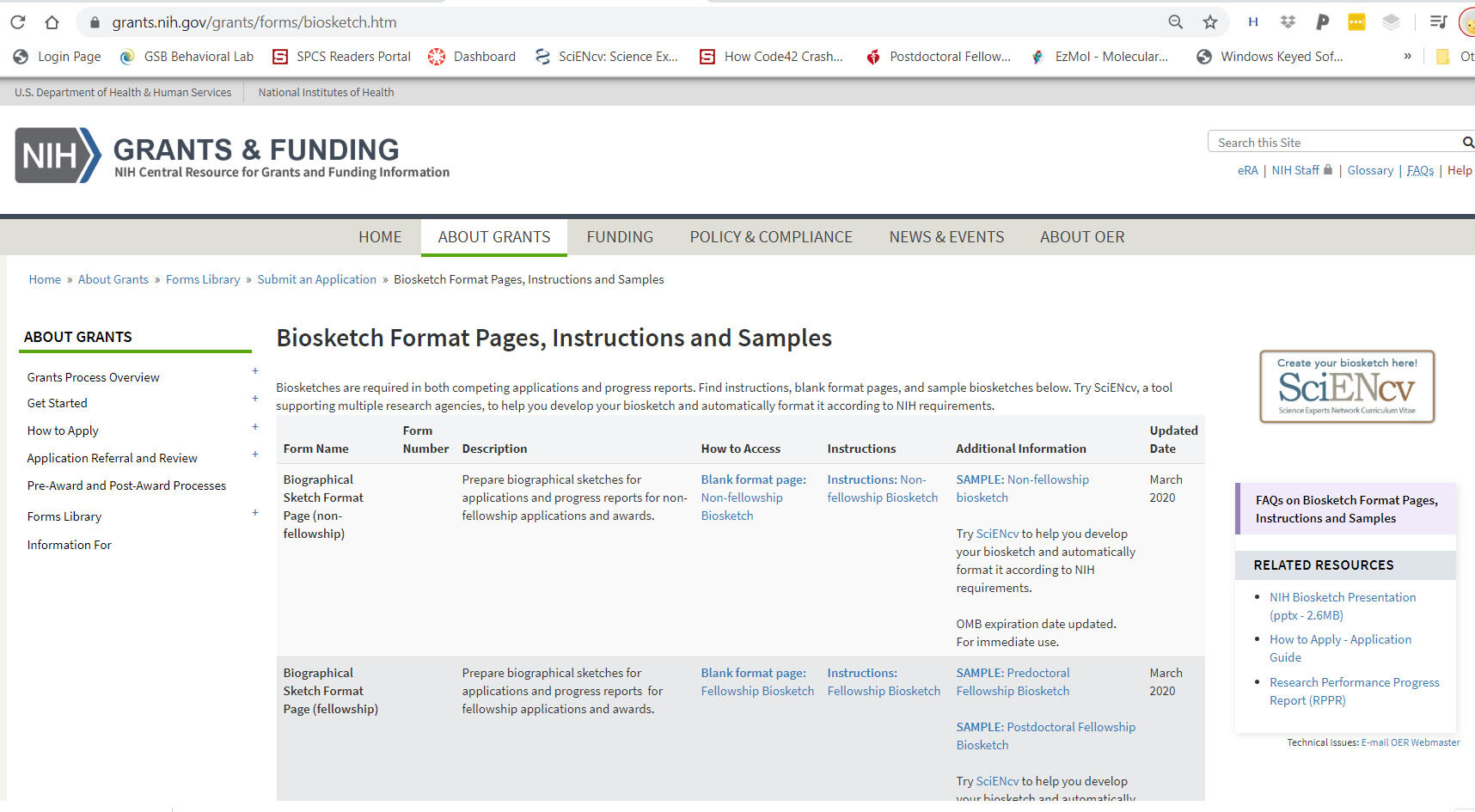Week 4: How to prepare a stellar NIH biosketch
Notes from Orit Rapaport’s amazing workshop/introduction to the NIH Biosketch
Introduction
In week 3, Orit Rapaport (from the Research Development Office within the Department of Pediatrics at Stanford) gave an incredibly informative introduction to the NIH biosketch.
Her amazing slides can be downloaded from the class Canvas website:
Canvas —> Modules —> Preparing your biosketch —> Workshop (Tips for generating stellar NIH biosketches)
Here are my personal notes from the workshop, I hope you find them helpful.
Biosketch background
The biosketch is required for all NIH grants and provides an opportunity to not only showcase your academic accomplishments, but also provide detailed information about why you are uniquely qualified to do the research proposed.
Download the instructions
To get started, go to the NIH Grants and Funding website and download the biosketch instructions and the biosketch examples. There are two different sets of instructions and three biosketch examples available for downloading. The instructions and examples/templates are slightly different, so make sure you download the one appropriate for the award you are applying for:
Non-fellowship Biosketch: Biosketches for K-awards (K01, K99, etc)
Under educational history (in the header), there are only completion dates listed (no start dates).
Do not include your grades at the end (i.e. scholastic performance).
Fellowship Biosketch: Biosketches for F-awards (F30, F31, F32, etc).
Under educational history (in the header), there are both start dates and end dates.
Include your grades at the end (i.e. scholastic performance).
For graduate students: Include both your undergraduate and graduate grades.
For postdocs: Include only your graduate grades
Using SciENcv to generate your biosketch (optional)
There are two ways in which people usually prepare their biosketches.
Download the appropriate biosketch sample from the NIH Grants and Funding website and modify it as needed
Use the NIH SciENcv website (linked to your My NCBI account) to create your biosketch. I personally used this option to make my biosketch and really liked it because it automatically formats your biosketch for you and properly formats your publications. All you need to do is input all your information and then export the file as either a Word Document or PDF. Importantly, if you download your biosketch as a Word Document, then you can continue making changes to it until you are satisfied with the final product.
recommended order of writing the biosketch
The biosketch can be roughly broken down into five components
Header (Name, ERA commons name, position title, education and training)
A. Personal Statement
B. Positions and Honors
C. Contributions to Science
D. Additional Information: Research Support and/or Scholastic Performance
However, Orit recommends writing the biosketch in this order, because the personal statement (the last part that you write) will be tailored to the other portions (which you will write first):
Contributions to science (Part C)
Positions and honors (Part B)
Additional Information (Part D)
Personal Statement (Part A)
tackling the contributions to science
Contributions by the numbers
Write up to five contributions to science
Include up to four publications or research products per contribution
Typically, each scientific contribution (including the publications) should occupy about half a page.
What is the definition of a publication or research product?
You can only include/cite accepted publications. However, you can mention papers in progress in the text.
You are allowed to include/cite preprints or other interim research products. However, you need to cite them properly. For full instructions regarding citing preprints or interim research products, refer to notice NOT-OD-17-050.
Research products can include, but are not limited to the following:
audio or video products; conference proceedings such as meeting abstracts, posters, or other presentations; patents; data and research materials; databases; educational aids or curricula; instruments or equipment; models; protocols; and software or netware. For more information about each category above, you can download the NIH Guide to Categorizing Products.
Orit’s five step guide to writing your contributions to science
Gather all of your papers and research products
Read through all your materials to re-familiarize yourself with the papers and research products.
Divide these papers and research products into a maximum of five groups (where there is a maximum of four papers/research products per each of the five groups/contributions). Orit mentioned that the manner in which you set up your groups/contributions is entirely up to you, but here are a few that are commonly used:
Career phases — Early (undergrad), graduate, and postdoctoral career
Different perspectives in science
Development of different state of the art tools
Varying translational impact
Instead of jumping directly into your research, for each contribution to science write a narrative/short story that includes these five components:
An opening or introduction of a problem in the field
A challenge in the form of a gap in knowledge or motivation
An action, which consists of what you did (your research contribution)
A climax, where you describe a result and its significance
A conclusion, end the paragraph with a statement indicating how this research has transformed or advanced the field
Cite up to four papers/research products for each scientific contribution
Note, here you want to be a bit strategic. Maximize your citations! If you have more than four papers that you want to cite in a single scientific contribution, consider splitting the scientific contribution to allow for citing all your papers.
Note, bold your name in each citation to help the reviewer identify your name in the list of authors.
Include a link to a bibliography at the end (optional)
This is optional, but Orit highly recommends that you include a link to your full bibliography at the end of your contributions to science. Importantly, the URL you provide must be from a Federal Government website (aka. you cannot use Google Scholar). It is highly recommended that you use the My Bibliography option that can be setup through My NCBI.
Tackling the positions and honors
It’s time to brag about yourself and how awesome you are! :)
Read the full instructions on the NIH Grants and Funding website and the NIH General Application Guide for NIH and other PHS Agencies, but here are a few of the important details:
List positions and honors in chronological order (oldest to newest/current)… you can list a future position/employment, just include the expected start date.
Look at the examples, the positions and honors for both fellowship and non-fellowship applications is roughly divided into three sections:
(1) Positions and employment — Your postdoc can be listed as a position (in addition to adding it to the header). You can include TA work here.
(2) Other experience and professional memberships — You can include volunteer work here.
(3) Honors — You can include travel awards here.
List any relevant academic or professional achievements and honors.
For students, postdocs, and junior faculty this includes scholarships, traineeships, fellowships, and development awards.
For clinicians this includes clinical licensures and specialty board certifications.
Note, certain large honors (like receiving an F31 as a graduate student) can and should be listed in multiple sections of your biosketch — it should be included as an honor (part B), but it can also be mentioned in your contributions to science (part C), mentioned in your personal statement (part A), and included in your research support (part D).
Tacking the Additional Information (Research Support and/or Scholastic Performance)
As always, read the instructions for this section in the NIH General Application Guide for NIH and other PHS Agencies.
Research support
List ongoing and completed research research projects (not pending projects) from the past three years.
Include both federal and non-federal funding.
For each research support listed…
Briefly indicate the overall goal of the project and your responsibilities.
Do not include the number of person months or % effort on the projec
Orit recommends listing the research support in order of relevance to the project
If you are not named as key personnel (a PI or Co-PI) on the grant, then you should not list this funding under the research support
Scholastic performance
A major difference between fellowship (F-grants) and non-fellowship (K-grants) applications, is that only fellowship applications include grades.
Predocs: List by institution and year all undergraduate and graduate courses, with grades.
Postdocs: List by institution and year all graduate scientific and/or professional courses, with grades.
Explain any grading system used if it differs from a 1-100 scale, A-F system, or a 0-4.0 scale. Also, indicate the levels required for a passing grade.
Tacking the personal statement
Last, but not least, it’s time to write the personal statement! Orit suggests writing the personal statement at the end, because it will be tailored to the specific proposal. As with all other sections of the biosketch, read carefully through the instructions in the NIH General Application Guide for NIH and other PHS Agencies.
Personal statement instructions
Briefly describe why you are well suited for your role(s) in this project.
Should include aspects of your training, previous experimental work on this topic, your technical expertise, your collaborators, your scientific environment, and/or past performance in this field.
At the end, you may cite up to four publications or research products that highlight your experiences and qualifications for this project.
Note, this is also where you have the opportunity to address factors that affected past scientific productivity (including a death in the family or other obligations).
Not explicitly written in the instructions, but the personal statement should be written in the first person and should fit on the first page (excluding the four citations).
Goals for the personal statement
Orit mentioned that the goals for the personal statement differ depending on if you are applying for a fellowship or non-fellowship, so keep this in mind when writing.
Fellowship (F-grant) goals: The personal statement should describe how the research proposed will provide you with the best possible training to advance your career.
Non-fellowship/career transition (K-grant) goals: The personal statement should describe how the research proposed will help you transition to an independent academic position.
Suggestions for writing the personal statement
By walking us through a well-written personal statement, Orit described lay out a excellent format to follow:
Start with career goals and motivations
Transition towards an exhibition of your research experience and here incorporate references to what you have already accomplished in science.
End with a statement regarding how the research proposed in this grant will advance your career. Here it is important to show some aspect of growth. Explain how the research proposed will (1) provide the training necessary to allow you to find your science niche and (2) help you use new tools (or a new perspective) to make significant advances in science.
Additional notes and final thoughts
A few final thoughts from Orit’s workshop:
No diagrams or figures are allowed in the biosketch.
Don’t forget to update your biosketch over time (continue to add positions and honors, update funding, update scholastic performance/grades, etc).
The biosketch should be tailored to each specific proposal.
For the NIH, you will attach the biosketch as a PDF file.
The biosketch cannot be longer than 5 pages long.
Make sure you adhere to other NIH guidelines regarding font type, font size, margins — refer to the NIH format guidelines.
Share with others, get feedback, and edit!
Additional resources
Books:
*Note, the information in the books regarding how to write your personal statement is very informative, but some of the specific guidelines are out of date, so refer to the NIH website for these details.
A Practical Guide to Writing a Ruth L. Kirschstein NRSA Grant. Andrew D. Hollenbach. 2nd edition. 2018. Access available from Science Direct with SUNet login.
Chapter 3 - Who are you? The fellowship applicant (pages 25-45).
The Grant Application Writer’s Workbook: National Institutes of Health Version. Russell, Stephen W. and David C. Morrison. Los Olivos, CA: Grant Writers’ Seminars and Workshops, LLC, 2016. www.grantcentral.com
Chapter 12 - Senior/key person profile(s) form, biographical sketches, and multiple PD/PI leadership plan of PHS 398 Research plan form
Websites
NIAID introduction to biosketches — A very short introduction to biosketches and what they should convey to the reviewer.
Videos from the Stanford Grant Writing Academy (some of these require a SUNet login for viewing)
Elements of scientific storytelling by Dr. Jennifer Stonaker (6 min).
An introduction to creating a narrative/story in your scientific contributions (i.e. how to incorporate an introduction/opening, challenge, action, climax, and resolution into your research).






